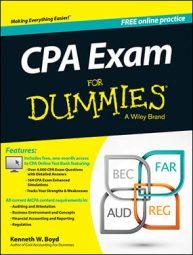For the CPA exam, you need to have a thorough understanding of what an is. When a CPA performs an audit, he or she is providing an opinion. The opinion concerns whether the financial statements present information fairly, in all material respects, and in conformity with applicable reporting standards. An audit opinion comments on whether the financial statements are free of material misstatement. Consider these additional points:
Being materially correct: The term material, which comes up throughout this book, refers to an issue or an amount that is relevant or important. An auditor doesn’t provide an opinion about the financials being exactly correct. The CPA provides a high level of assurance but not an absolute level of assurance. Instead, the auditor gives an opinion as to whether the financials are materially correct.
Adherence to reporting standards: Every entity has reporting standards for their particular set of financial statements. Regulators and industry standards require certain standards for financial reporting. As an example, public companies (those that issue securities to the public) must comply with SEC reporting standards. An auditor may state that the client has complied with SEC reporting requirements.
Financial statements: The audit report addresses the company’s financial position, the results of operations, and cash flows. Later in this chapter, you see the specific financial statements that are part of an audit.
Disclaimers and adverse opinions: A CPA may disclaim an opinion or issue an adverse opinion. I explain disclaimers and adverse opinions later in the chapter.
Generally accepted auditing standards (GAAS) is a system of guidelines that CPAs use when performing audits. (You can find out about GAAS by visiting the AICPA website.) GAAS requires an auditor to obtain an understanding of the company’s internal controls and to assess fraud risk.
Fraud is broadly defined as willful intent to deceive. For auditing purposes, fraud risk is the risk that a company employee will intentionally attempt to misstate the financial statements.
GAAS also requires the CPA to corroborate the amounts and disclosures in the financial statements. Auditors corroborate this information by gathering audit evidence. The client-produced accounting records aren’t sufficient evidence to provide an opinion on the financial statements. The CPA must complete more procedures and gather more evidence. Here are several procedures for gathering audit evidence:
Inquiry: Ask company management and staff about certain accounting transactions. If, for example, the accounts receivable balance is increasing faster than sales, the CPA may ask management why customers are paying more slowly. The client’s answer may help explain the growing accounts receivable balance.
Physical inspection: A CPA often physically inspects assets to confirm their existence. For example, an accountant often performs physical counts of inventory near the balance sheet date. The balance sheet date is the date on the balance sheet that’s under audit.
The balance sheet date is also always that last day of the company’s fiscal year (December 31, for example). The CPA compares the items listed in the inventory records with the physical items she counts in the warehouse.
Observation: Accountants gather audit evidence by simply watching employees perform tasks. Say that a company has a control in place for shipping. The shipping department ensures that each customer shipment matches details on the invoice that’s also sent to the client. A CPA can visit the shipping department and see whether the employees are comparing the invoices to the shipping documents.
Third-party confirmation: Generally, confirming information with a third party — someone outside the company — is considered more reliable than data from within the company. The third party has less motivation to manipulate data than the company being audited does.
CPAs often send written confirmations to outside parties that do business with the client. For example, a CPA may send copies of invoices to customers and ask them to confirm whether the invoice is for items they actually bought.
If the client owes money based on the invoice, the confirmation process helps corroborate accounts receivable. The CPA firm should mail the confirmations and have the completed confirmations mailed to the CPA firm’s office. This process prevents any manipulation by the client under audit.
Examination: CPAs review records to determine whether transactions were handled correctly. Suppose the company has issued long-term debt using a corporate bond. The accountant reviews the loan document to confirm the interest expense due each year. The CPA can then check the cash account activity to confirm that the interest was actually paid.
To audit the number of common stock shares outstanding, the CPA reviews the number of shares held by the public according to the registrar’s records. A registrar is an independent company that tracks the ownership of stock for a particular company. The registrar’s records should agree with the common stock shares outstanding in the company financial statements.
Analytical review: Analytical review considers trends and comparisons in the financial statements. Suppose that the CPA notices that the cash balance is declining during the year. The client is collecting cash more slowly. If the accountant notices that the accounts payable balance is increasing, that would be consistent with a declining cash balance. The company is collecting cash more slowly, so payables are increasing.
All the steps needed to audit a particular area of the company are listed in an audit program. You can think of an audit program as a checklist. In fact, auditors initial or input a checkmark on each step of the audit program as they complete work. If an auditor finds that an account balance needs to be changed, she proposes an adjusting entry.

